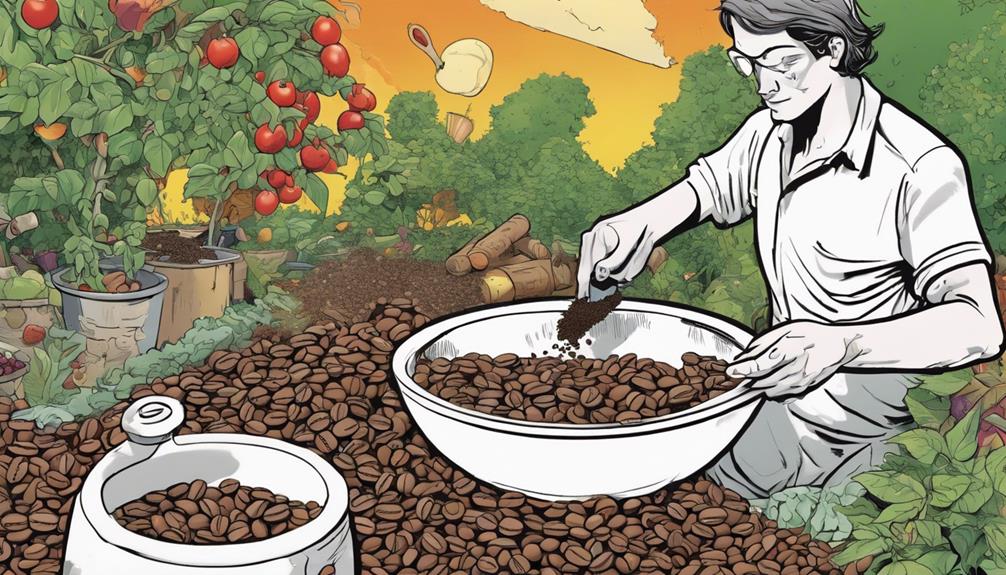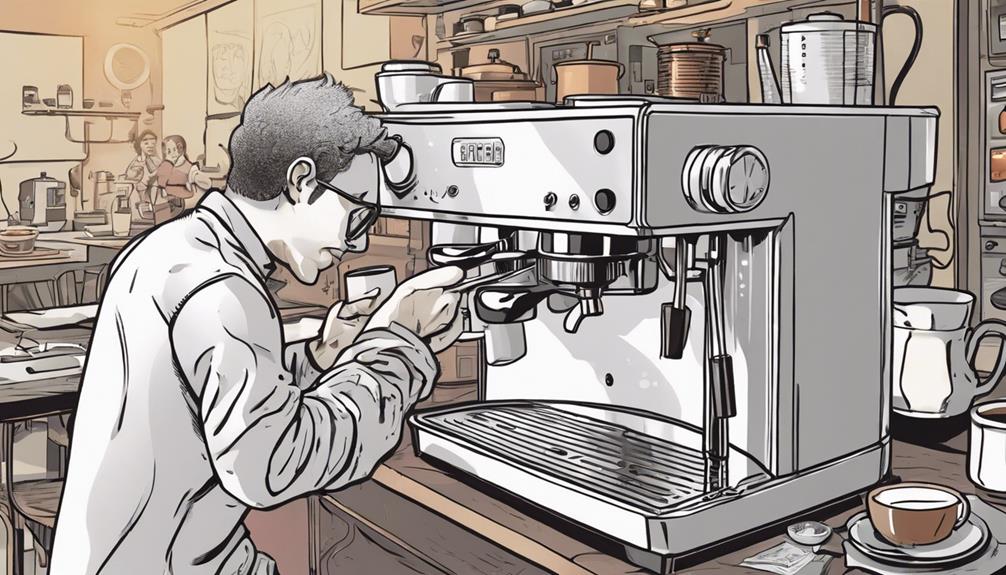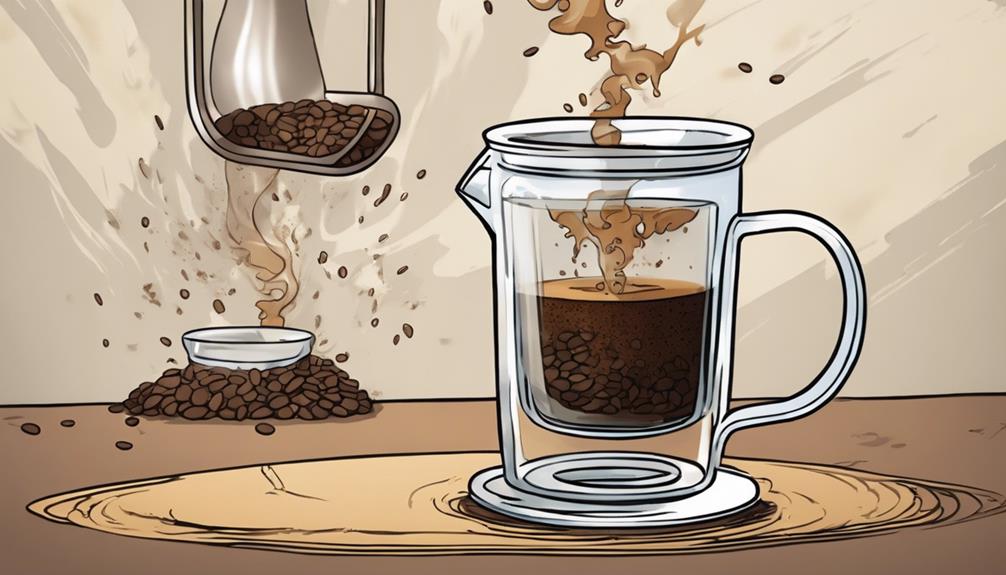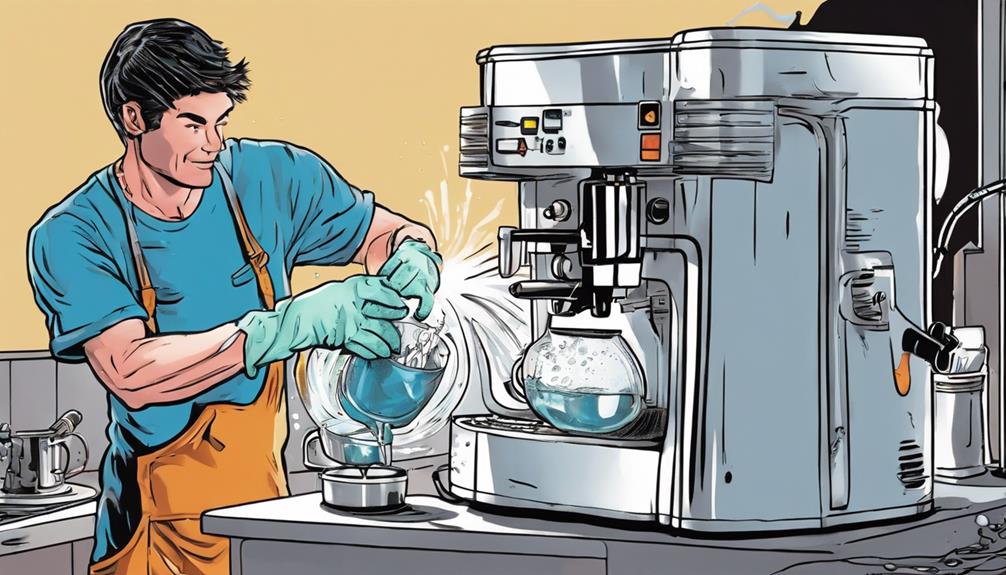Break up coffee beans in order to enhance your garden! Combine them with compost for important nutrients, improved soil quality, and balanced pH levels. Increase decomposition by introducing worms to generate soil rich in nutrients. Layer coffee beans to improve aeration, maintain moisture balance, and enhance soil health. Monitor pH levels for successful composting. Coffee grounds support vigorous plant growth, attract beneficial organisms, and encourage sustainable gardening. Therefore, be prepared to revolutionize your garden with nutrient-rich soil and flourishing plants!
Key Takeaways
- Mix coffee beans with compost materials for balanced nutrients.
- Enhance decomposition with worms like red wigglers.
- Layer coffee beans for aeration and moisture balance.
- Monitor pH levels for optimal decomposition.
- Promote sustainable gardening with coffee grounds.
Incorporating Coffee Husks for Nutrient Balance
To achieve the best nutrient balance in your compost, consider incorporating coffee husks along with coffee grounds. Coffee husks, being the outer layer of the coffee bean, are packed with essential nutrients like potassium, magnesium, and phosphorus.
When composting coffee grounds, adding coffee husks helps balance the nitrogen-rich grounds, creating a more complete nutrient profile for your garden soil.
Not only do coffee husks enrich the compost with valuable nutrients, but they also play an important role in improving soil structure. Their presence aids in moisture retention and helps regulate pH levels, creating an ideal environment for plant growth.
Additionally, the introduction of coffee husks into compost encourages beneficial microbial activity, which in turn promotes decomposition and the release of nutrients essential for plant health.
Mixing Coffee Grounds With Compost Materials

Mixing coffee grounds with compost materials introduces nitrogen to the pile, enhancing soil structure and promoting decomposition.
When combined with other compost materials, coffee grounds can help balance pH levels, increase moisture retention, and improve soil quality.
Mixing coffee grounds with brown materials like leaves in the compost pile aids in the decomposition process, optimizing a nutrient-rich end product for your garden.
The addition of coffee grounds to your compost pile can also attract beneficial organisms that further break down organic matter and enrich the soil.
By properly mixing coffee grounds with compost materials, you create an ideal environment for the breakdown of organic matter and the availability of nutrients for your plants.
Remember to layer your coffee grounds within the compost pile to ensure uniform distribution and efficient decomposition.
With the right mix of coffee grounds and compost materials, you can create a fertile soil amendment that will benefit your garden plants.
Enhancing Decomposition With Worms
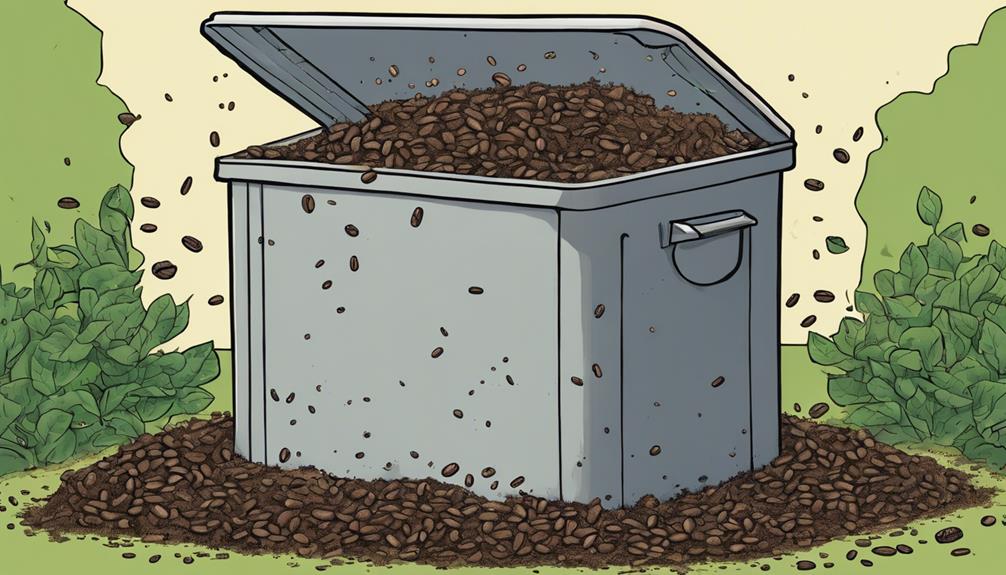
Worms play a crucial role in accelerating the decomposition of coffee beans in compost, contributing to nutrient-rich soil for your garden.
These diligent creatures, especially red wiggler worms like Eisenia fetida, are key players in vermicomposting coffee grounds. By consuming organic matter, worms create nutrient-rich castings that enhance soil structure, microbial activity, and provide essential nutrients for plant growth.
Additionally, worms help aerate the compost pile, prevent compaction, and speed up the decomposition process of coffee beans.
Introducing worms to your compost with coffee grounds establishes a symbiotic relationship that benefits both the worms and your garden soil. As worms work tirelessly underground, they transform coffee grounds into valuable resources that enrich your garden.
Layering for Aeration and Moisture

When layering coffee beans in your compost pile, you can improve aeration by allowing oxygen to reach the microorganisms that break down the organic matter.
Ensuring a proper mix of coffee beans with other compost materials like leaves and grass clippings will help maintain balanced moisture levels for efficient decomposition.
Remember to alternate coffee bean layers with brown materials like straw to prevent compacting and promote better airflow in your compost.
Aerate Soil With Coffee
To improve soil aeration and moisture retention, consider layering coffee grounds within your compost mix. Coffee grounds, when integrated into compost, create pockets for air circulation, enhancing soil structure.
These grounds act as a natural sponge, aiding in retaining moisture in the soil and reducing water runoff. By layering coffee grounds properly, you can prevent soil compaction, enabling roots to access nutrients easily.
Additionally, the decomposition of coffee grounds adds organic matter to the soil, promoting microbial activity and enhancing overall soil health. To ensure a balanced decomposition process and best aeration levels, mix coffee grounds with other compost materials like leaves or straw.
Enhance Moisture Retention
Layer coffee grounds strategically in your compost mix to enhance moisture retention and support aeration for best soil health.
Coffee grounds play a pivotal role in improving moisture retention by acting as a sponge within your compost pile. They help prevent excessive evaporation by holding onto water and releasing it gradually to support plant roots.
Additionally, the presence of coffee grounds in well-aerated compost facilitates better water distribution throughout the soil, ensuring that your plants receive the hydration they need.
Besides, the inclusion of coffee grounds creates a balanced environment for beneficial microorganisms that aid in decomposition and regulate moisture levels effectively.
By employing the layering technique with coffee grounds, you can maintain consistent moisture levels in your compost, which is essential for fostering healthy plant growth in your garden.
Make the most of coffee grounds to enhance moisture retention and create an ideal environment for your plants to thrive.
Monitoring Ph Levels for Success
For successful breakdown of coffee beans in your garden, ensuring proper pH levels in your compost is important. Monitoring pH levels is essential as coffee grounds are initially acidic, and maintaining a balanced environment is key for effective decomposition.
Regularly testing pH levels can prevent imbalances that might impede the breakdown process of coffee beans. By adjusting pH levels as necessary, you can optimize the composting process, leading to the creation of nutrient-rich soil for your garden.
Keeping pH levels in check not only promotes microbial activity but also enhances decomposition, ensuring the overall effectiveness of using coffee beans in compost. Remember, a well-balanced pH level is crucial for the success of your composting efforts and plays a significant role in the quality of the soil you'll be using for your garden.
Achieving Nutrient-Rich Soil

Enhance nutrient absorption, improve soil structure, and promote microbial activity in your garden by composting coffee beans.
The essential nutrients released during the breakdown of coffee beans contribute to healthier plants and a balanced ecosystem.
Nutrient Absorption Enhancement
Enhance the nutrient absorption in your garden soil by incorporating coffee grounds, which decompose slowly and release necessary nutrients over time. When you improve nutrient absorption in your soil through coffee bean breakdown, you provide valuable benefits for your plants:
- Slow Release: Coffee grounds break down gradually, ensuring a steady release of nutrients for plant uptake.
- Nitrogen Boost: The decomposition process of coffee beans enriches the soil with nitrogen, an essential nutrient for plant growth.
- Essential Nutrients: Coffee beans also release potassium, phosphorus, and various other necessary nutrients critical for healthy plant development.
- Balanced Mix: Incorporating coffee grounds into your compost helps create a balanced mix of organic matter, optimizing nutrient absorption by plants.
Soil Structure Improvement
Incorporating coffee grounds into your compost can greatly enhance the soil structure, promoting nutrient-rich soil necessary for healthy plant growth. Coffee grounds play a crucial role in improving soil structure by enhancing aeration and water retention. As they break down slowly, coffee grounds release nutrients like nitrogen, potassium, and magnesium, providing essential elements for plant uptake. The organic matter present in coffee grounds aids in building nutrient-rich soil, creating a favorable environment for plant growth.
When mixed with other compost materials, coffee grounds contribute to creating a balanced ecosystem for beneficial soil organisms. This collaboration results in improved soil structure, benefiting plants with healthier root systems, enhanced nutrient absorption, and overall importance.
Microbial Activity Promotion
To promote nutrient-rich soil in your garden, consider how incorporating coffee grounds into your compost fuels microbial activity, benefiting plant growth. Microbial activity promotion is essential for breaking down organic matter and releasing valuable nutrients for your plants.
Here are four key points to understand how coffee grounds enhance microbial activity in your compost:
- Organic Matter Breakdown: The presence of coffee grounds in your compost provides a food source for microbes, accelerating the decomposition of organic matter.
- Nutrient Release: Microbes feed on coffee beans, converting them into essential nutrients like nitrogen and potassium that are easily absorbed by plants.
- Soil Health Improvement: Coffee grounds contribute to the diversity of beneficial microbes in the soil, promoting a healthier soil ecosystem.
- Nutrient-Rich Soil: The active microbial activity fueled by coffee grounds results in nutrient-rich soil, creating ideal conditions for robust plant growth.
Promoting Sustainable Gardening Practices

Enhance your garden's sustainability by embracing composting coffee grounds as a key practice. Sustainable gardening involves utilizing coffee bean compost to reduce waste and enrich the soil with essential nutrients.
By incorporating coffee grounds into your compost pile, you can help retain moisture in the soil, improve its structure, and attract beneficial organisms like earthworms and microbes that aid in decomposition.
Composting coffee beans not only supports eco-friendly initiatives but also promotes natural fertilization methods, reducing the need for chemical fertilizers that can harm the environment. Breaking down coffee beans in your garden can enhance plant growth while aligning with efforts to protect the environment and encourage organic gardening practices. Additionally, breaking coffee beans into compost can contribute to the reduction of waste sent to landfills, as coffee grounds are often thrown away in large quantities. By repurposing these grounds as compost, gardeners can help minimize their environmental impact. Breaking coffee beans down in your garden also provides a natural and sustainable way to improve soil quality, benefiting the overall health of your plants.
Embracing sustainable gardening practices through coffee bean composting is a simple yet impactful way to contribute to a healthier ecosystem and create a thriving garden that benefits both you and the environment.
Frequently Asked Questions
How Long Does It Take for Coffee Grounds to Break Down in Compost?
Coffee grounds break down in compost within 2-6 months; factors like method, temperature, and moisture affect the process. Mixing with organic matter speeds it up. Turn the pile regularly for aeration, aiding breakdown efficiently.
Can I Put Whole Coffee Beans in Compost?
Yes, you can put whole coffee beans in compost, but they take longer to break down. Grinding coffee beans beforehand accelerates decomposition. Ground coffee provides more surface area for microbes to work effectively, releasing nutrients faster.
How to Compost Coffee Grounds in the Garden?
To compost coffee grounds in the garden, mix them with brown materials like leaves for decomposition. This enriches soil with nitrogen, retains moisture, and attracts beneficial organisms. Add grounds to compost piles in moderation for best results.
How to Use Whole Coffee Beans in the Garden?
To use whole coffee beans in the garden, grind them for a natural fertilizer. Ground beans enrich soil with nutrients, improve structure, and enhance plant growth. Think of it like brewing a nutrient-rich garden elixir with each sprinkle of coffee goodness.
Conclusion
To sum up, breaking down coffee beans for your garden can help create nutrient-rich soil and promote sustainable gardening practices.
So next time you brew a cup of coffee, don't throw away those grounds – put them to good use in your garden!
Remember, a little extra effort now can lead to bountiful harvests later.
Happy gardening!
